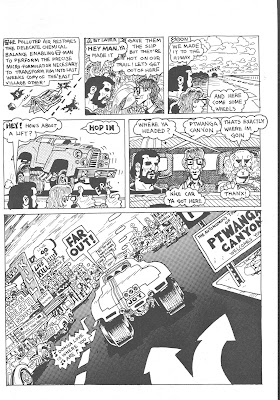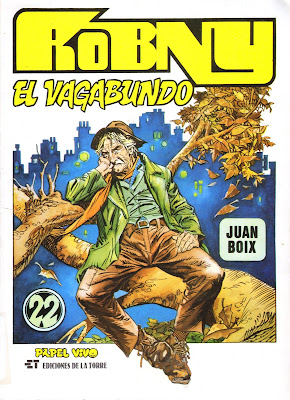Trashman Meets the Fighting She Devils
by Spain
from Subvert Comics No. 1
Rip-Off Press, 1970
NOTE: this comic is likely to offend modern sensibilities..........
Thursday, April 5, 2018
Monday, April 2, 2018
Book Review: Strangler
This summary is not available. Please
click here to view the post.
Labels:
Strangler
Friday, March 30, 2018
Robny the Tramp in 'Scrap'
Robny the Tramp
by Juan Boix
in Chatarra ('scrap')
1976
In 1976 the Spanish artist Juan (also spelled as 'Joan') Boix (b. 1945) created what would be a series of comics about Robny the Tramp (Robny el Vagabundo). Robny was a writer who decided to take up life on the streets as a means of finding artistic inspiration and insights into the human condition. The initial episodes appeared in Spanish magazines such as Spirit and Senda del Comic.
In 1981 the Robny stories were compiled by Spanish publisher Ediciones de la Torre in issues 22 and 27 of its Papel Vivo ('Live Paper') comic book. A one-volume compilation of the Robny stories was published in 2011 by Dolmen.
Sadly, much of Boix's work, including Robny, has not been translated into English. Perhaps IDW, as it is now doing with the early work of Esteban Maroto, will issue Boix's comics in English in nicely produced hardbound editions.
In any event, whether you are fluent in Spanish or not, the artwork in this Robny strip, titled Chatarra ('Scrap'), is exceptional and can be understood regardless of your language skills.
by Juan Boix
in Chatarra ('scrap')
1976
In 1976 the Spanish artist Juan (also spelled as 'Joan') Boix (b. 1945) created what would be a series of comics about Robny the Tramp (Robny el Vagabundo). Robny was a writer who decided to take up life on the streets as a means of finding artistic inspiration and insights into the human condition. The initial episodes appeared in Spanish magazines such as Spirit and Senda del Comic.
In 1981 the Robny stories were compiled by Spanish publisher Ediciones de la Torre in issues 22 and 27 of its Papel Vivo ('Live Paper') comic book. A one-volume compilation of the Robny stories was published in 2011 by Dolmen.
Sadly, much of Boix's work, including Robny, has not been translated into English. Perhaps IDW, as it is now doing with the early work of Esteban Maroto, will issue Boix's comics in English in nicely produced hardbound editions.
In any event, whether you are fluent in Spanish or not, the artwork in this Robny strip, titled Chatarra ('Scrap'), is exceptional and can be understood regardless of your language skills.
Labels:
Robny the Tramp
Wednesday, March 28, 2018
Mike Hinge and Lou Stathis
Mike Hinge and Lou Stathis
This photo was apparently taken at a sci-fi fan gathering sometime in the 1970s.
Mike Hinge (left) (1931 - 2003) was a New Zealand-born artist who contributed some memorable artwork to Heavy Metal magazine in the 80s.
Lou Stathis (center) (1952 - 1997) wrote the 'rok' (i.e., rock) music column for Heavy Metal during the late 70s and early 80s.
I don't know who John Singer (right) was / is.....?
The photo is credited to Steve Stiles, http://fanac.org
This photo was apparently taken at a sci-fi fan gathering sometime in the 1970s.
Mike Hinge (left) (1931 - 2003) was a New Zealand-born artist who contributed some memorable artwork to Heavy Metal magazine in the 80s.
Lou Stathis (center) (1952 - 1997) wrote the 'rok' (i.e., rock) music column for Heavy Metal during the late 70s and early 80s.
I don't know who John Singer (right) was / is.....?
The photo is credited to Steve Stiles, http://fanac.org
The website Onyx Cube, while not maintained after 2017, contains some interesting information about Mike Hinge and his artwork.
Labels:
Mike Hinge and Lou Stathis
Tuesday, March 27, 2018
Delores Taylor RIP
Delores Taylor, RIP
27 September 1932 - 23 March 2018
27 September 1932 - 23 March 2018
Delores Taylor on a press junket for Billy Jack, Minneapolis area, 1970s
Delores Taylor died recently at age 85. While she was best known for playing schoolteacher Jean Roberts opposite her husband Tom Laughlin (1931 - 2013) in the Billy Jack films, she played a significant role behind the camera in helping Laughlin produce the films.
Labels:
Delores Taylor RIP
Sunday, March 25, 2018
Book Review: The Owl
Book Review: 'The Owl' by Robert Forward
2 / 5 Stars
The Owl (247 pp) was published by Pinnacle Books in August 1984; the cover artist is uncredited.
A sequel, titled The Owl: Scarlet Serenade was published in 1990.
The Owl is set in Los Angeles in the early 1980s. The protagonist, Alexander L'Hiboux, suffers - if that's the right word - from 'insomnolence', the inability to sleep. This condition has led him to adopt the career of a vigilante for hire: The Owl. Throughout the L.A. underworld, the name of the Owl is enough to strike fear into the most vicious of criminals and evildoers, for the Owl doesn't rest until he has exacted vengeance.
The opening chapter of the novel is a textbook example of hard-boiled writing as the Owl copes with a mugger, resulting in a graphic depiction of gun violence and making clear to the reader that the Owl isn't one to be merciful to his enemies. Indeed, as the novel progresses, author Forward demonstrates that Alexander L'Hiboux is as psychotic in his zeal for vigilantism as the mental cases he encounters while wandering the late night streets of L.A.
Having set the tone in his initial chapters, author Forward then embarks on the main plot: a man named Paul Jackson has hired the Owl to find, and eliminate, the individual who maimed Jackson's 20 year-old daughter Lei with a blowtorch.
The appalling nature of this crime means that the Owl doesn't need much in the way of motivation to find the perpetrator. But nothing is as easy as it seems, and L'Hiboux soon finds himself targeted by a syndicate that has no qualms about snuffing out any vigilante who insists on sticking his nose into places where it doesn't belong..............
Much like L. A. Morse's The Big Enchilada, the intensely hard-boiled nature of the author's prose style in The Owl will lead the reader to suspect that the narrative regularly crosses the line into parody, or even satire.
This is particularly true of the second half of The Owl, and it's a real weakness as far as I was concerned: the Owl's escapades rapidly move from the realm of the private eye, to the realm of comic book superhero. I won't disclose any spoilers, but the shootouts with the bad guys and the resulting 'it was only a flesh wound, but it hurt like hell' contrivances had my eyes rolling.
It doesn't help matters that the obligatory four-page 'Explanation of Whodunnit' section in chapter 31 is so convoluted, and so dependent on lucky coincidences, that even after re-reading it several times, it remained incoherent.
The verdict ? Although it starts off very well, the latter half of the novel obliges the reader to willingly suspend belief........and then some. If you're willing to go that route then you may want to pick up The Owl. All others likely will want to pass.
Labels:
The Owl
Friday, March 23, 2018
The Pastel City by Bruce Pennington
'The Pastel City'
by Bruce Pennington
wraparound cover artwork for the 1971 New English Library paperback by M. John Harrison
by Bruce Pennington
wraparound cover artwork for the 1971 New English Library paperback by M. John Harrison
Thursday, March 22, 2018
The Cursed Earth chapters 1 and 2
Judge Dredd: The Cursed Earth
Chapters 1 and 2
by Pat Mills (script) and Mike McMahon (art)
2000 AD comics, May 1978
It's hard to believe that it was 40 years ago that 2000 AD comics began its first major story arc involving Judge Dredd: an epic, 25-chapter adventure titled The Cursed Earth. From Prog 61 (which had a cover date of 20 April 1978) to Prog 85 (7 October 1978), fans were treated to something entirely new and novel in the Judge Dredd universe.
At the time, no one in the US outside of a few dedicated fans of British comics even knew that The Cursed Earth was up and running, but it has since turned out to be one of the greatest comics of the 70s.
Printed in black and white and featuring Mike McMahon's distinctive artwork, which made up in its energy and dynamism for its lack of polish, The Cursed Earth combined sci-fi with violent action to fashion something quite unlike anything else appearing in English-language comics.
The uniquely British sense of humor that permeated the comic gave it a nasty, satiric flavor that simply didn't exist in American comics of the same era.
Showing the influence of contemporary English pop culture on the tenor of Judge Dredd, the second chapter introduced one of the most memorable characters in the 2000 AD lineup: the punk, and reprobate, 'Spikes Harvey Rotten'.
As chapter 2 opens, Rotten is visiting a grammar school in order to tell the kids 'how terrible it is to be a lawbreaker', because, according to the confident warden of the Mega-Penitentiary that rehabilitated Rotten, 'we reform ninety-nine per cent of our prisoners here, you know.' Pat Mills's script takes this assertion and turns it into black comedy, as only Dredd can save the innocent from a looming bloodbath.
There are a number of compilations of the series that have been released over the years; the newest version, 2016's The Cursed Earth: Uncensored, features material that was deleted from early compilations for fear of trademark infringement litigation.
Posted below are the first two chapters of The Cursed Earth.
Chapters 1 and 2
by Pat Mills (script) and Mike McMahon (art)
2000 AD comics, May 1978
It's hard to believe that it was 40 years ago that 2000 AD comics began its first major story arc involving Judge Dredd: an epic, 25-chapter adventure titled The Cursed Earth. From Prog 61 (which had a cover date of 20 April 1978) to Prog 85 (7 October 1978), fans were treated to something entirely new and novel in the Judge Dredd universe.
At the time, no one in the US outside of a few dedicated fans of British comics even knew that The Cursed Earth was up and running, but it has since turned out to be one of the greatest comics of the 70s.
Printed in black and white and featuring Mike McMahon's distinctive artwork, which made up in its energy and dynamism for its lack of polish, The Cursed Earth combined sci-fi with violent action to fashion something quite unlike anything else appearing in English-language comics.
The uniquely British sense of humor that permeated the comic gave it a nasty, satiric flavor that simply didn't exist in American comics of the same era.
Showing the influence of contemporary English pop culture on the tenor of Judge Dredd, the second chapter introduced one of the most memorable characters in the 2000 AD lineup: the punk, and reprobate, 'Spikes Harvey Rotten'.
There are a number of compilations of the series that have been released over the years; the newest version, 2016's The Cursed Earth: Uncensored, features material that was deleted from early compilations for fear of trademark infringement litigation.
Posted below are the first two chapters of The Cursed Earth.
Subscribe to:
Posts (Atom)







































































